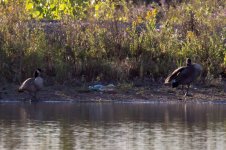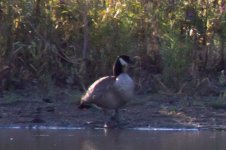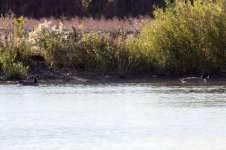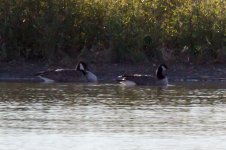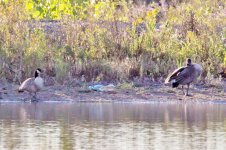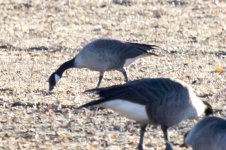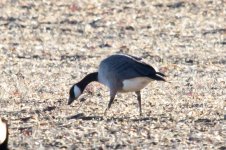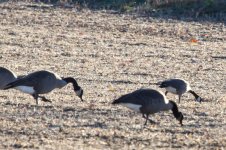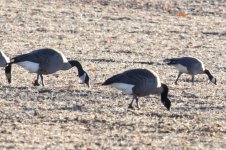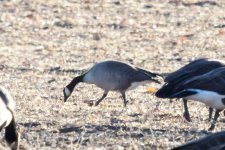-
Welcome to BirdForum, the internet's largest birding community with thousands of members from all over the world. The forums are dedicated to wild birds, birding, binoculars and equipment and all that goes with it.
Please register for an account to take part in the discussions in the forum, post your pictures in the gallery and more.
You are using an out of date browser. It may not display this or other websites correctly.
You should upgrade or use an alternative browser.
You should upgrade or use an alternative browser.
Canada or Cackling Goose? (1 Viewer)
- Thread starter mordovarot
- Start date
More options
Who Replied?Nutcracker
Stop Brexit!
birdmeister
Well-known member

This is one of those sort of intermediate birds...
I would lean towards Cackling given its smaller size and what I perceive as a short bill and small head. However, in image 3, its body looks almost disproportionately large compared to the neck and head (clearly smaller than the Canada, comparing "chinstraps"). Still, I've heard from a well-respected expert in the western US that Cackling has quite a bit of variation, and many birds that we're hesitant to call in the East he says are just fine.
I would lean towards Cackling given its smaller size and what I perceive as a short bill and small head. However, in image 3, its body looks almost disproportionately large compared to the neck and head (clearly smaller than the Canada, comparing "chinstraps"). Still, I've heard from a well-respected expert in the western US that Cackling has quite a bit of variation, and many birds that we're hesitant to call in the East he says are just fine.
mordovarot
Well-known member
Thanks a lot for your opinions!
And will wait for possible others
And will wait for possible others
mordovarot
Well-known member
By the way, nothing was said about its neck. Isn't it too long for Cackling? This is worrying me more then other features...
Deb Burhinus
Used to be well known! 😎

I think we can safely rule out a ‘Cackling Goose’ minima these are the smallest and darkest of the variant forms. The OP is too large and pale. On range you could probably rule out a Taverner’s (taverneri.) There’s also Lesser Canada Goose (parvipes) (part of the Canada Goose canadensis) (which can be indistinguishable from Taverner’s!) although the steep forehead and flattish crown doesn’t favor this option. There is also Todd’s Canada Goose (interior) but I think we can rule that out on size (also the OP has quite a thick neck). My very loose and tentative guess would be Richardson’s Canada Goose (hutchinsii) which not only would be better than the others on range but which are small and pale, they also have a thick neck however, even with good views these forms are a nightmare.
There are several more forms than this too - about 11 taxa in the Cackling Goose/Canada Goose complex! Clear as mud?
You would need much clearer images to pin the OP down to race imo but the small size and short legs suggest it’s not a Canada Goose but rather one of the hutchinsii variants, likely B.h.hutchinsii Richardson’s.
I lived for many years close to a nature reserve/reservoir that had regular Cackling type geese - along with Bar-headed and Egyptian Geese, which all mixed with the Canada Geese - all presumably from feral populations though (especially the minima and not sure whether any were hybrids either!)
Vagrant Richardson’s have turned up in Norfolk and elsewhere (being an Eastern Seaboard species) and are larger than ‘Cackling Goose’ -
https://gobirding.eu/Photos/LesserCanadaGoose.php
Edit - I know you raised the point about neck length but this can not be judged in photos - geese (and egrets!) can go from having short necks to long ones depending on posture!
There are several more forms than this too - about 11 taxa in the Cackling Goose/Canada Goose complex! Clear as mud?
You would need much clearer images to pin the OP down to race imo but the small size and short legs suggest it’s not a Canada Goose but rather one of the hutchinsii variants, likely B.h.hutchinsii Richardson’s.
I lived for many years close to a nature reserve/reservoir that had regular Cackling type geese - along with Bar-headed and Egyptian Geese, which all mixed with the Canada Geese - all presumably from feral populations though (especially the minima and not sure whether any were hybrids either!)
Vagrant Richardson’s have turned up in Norfolk and elsewhere (being an Eastern Seaboard species) and are larger than ‘Cackling Goose’ -
https://gobirding.eu/Photos/LesserCanadaGoose.php
Edit - I know you raised the point about neck length but this can not be judged in photos - geese (and egrets!) can go from having short necks to long ones depending on posture!
Last edited:

I think we can safely rule out a ‘Cackling Goose’ minima these are the smallest and darkest of the variant forms. The OP is too large and pale. On range you could probably rule out a Taverner’s (taverneri.) There’s also Lesser Canada Goose (parvipes) (part of the Canada Goose canadensis) (which can be indistinguishable from Taverner’s!) although the steep forehead and flattish crown doesn’t favor this option. There is also Todd’s Canada Goose (interior) but I think we can rule that out on size (also the OP has quite a thick neck). My very loose and tentative guess would be Richardson’s Canada Goose (hutchinsii) which not only would be better than the others on range but which are small and pale, they also have a thick neck however, even with good views these forms are a nightmare.
There are several more forms than this too - about 11 taxa in the Cackling Goose/Canada Goose complex! Clear as mud?
You would need much clearer images to pin the OP down to race imo but the small size and short legs suggest it’s not a Canada Goose but rather one of the hutchinsii variants, likely B.h.hutchinsii Richardson’s.
I lived for many years close to a nature reserve/reservoir that had regular Cackling type geese - along with Bar-headed and Egyptian Geese, which all mixed with the Canada Geese - all presumably from feral populations though (especially the minima and not sure whether any were hybrids either!)
Vagrant Richardson’s have turned up in Norfolk and elsewhere (being an Eastern Seaboard species) and are larger than ‘Cackling Goose’ -
https://gobirding.eu/Photos/LesserCanadaGoose.php
Edit - I know you raised the point about neck length but this can not be judged in photos - geese (and egrets!) can go from having short necks to long ones depending on posture!
I believe you can only say the part I highlighted using bold if you have truly been able to exclude parvipes - which I am not sure about.
Niels
Deb Burhinus
Used to be well known! 😎

I believe you can only say the part I highlighted using bold if you have truly been able to exclude parvipes - which I am not sure about.
Niels
Neils, Lesser Canada parvipes are much less likely in the North Eastern US - they breed further West than Richardson’s and are short distant migrants - so immediately just on range, Richardson’s is more likely. . The reference to bill size that you use in your above #3 post to point to a Canada is not really applicable when clearly this is not a Canada Goose based on the size of the bird compared to the Canada Goose next to it (assuming that the larger one is a Canada not a Lesser). As far as Lesser Canada parvipes you refer to in your above post, they tend to have more triangular combined shaped head/bill (which I don’t see in the OP) but the bills if anything are proportionately actually more stubby than Richardson's (comparing bill length to bill depth ratio)
Note particularly the size and shape of the head v bill in the OP and compare here:
https://www.sibleyguides.com/2010/09/bill-size-not-shape-distinguishes-cackling-and-canada-goose/
Lesser do not have such steep foreheads (as in the OP), they have skinnier necks and are more similar to Canada in colour. The OP (especially in the lightened image) to me looks pale both on the mantle and the breast with the thick neck of a Richardson and the size of the bird (best seen in the first image where the leg length can be seen) looks rather small imo.
Note, I said ‘likely’ a Richardson’s and ‘suggest’ this points to that race, so yes, this can be said without excluding Lesser but imo, for the reasons stated, I prefer Richardson’s over the former. However, I have not and did not rule out other forms in my previous post, in fact I said you need clearer images to pin this down. I also said even with good views ‘these forms are a nightmare’.
So I think by selective bold highlighting out of the context of my overall answer you gave my conclusion more certainly than I intended. A conclusion that was a only suggestion based on my experience with Richardson’s but not an absolute certainty. Nor, does it in my experience exclude the possibility of intergrades or hybrids.
Last edited:
mordovarot
Well-known member
https://ebird.org/checklist/S74226055
Thanks a lot for the discussion on my topic!!!
The link above has a photo from another observer of a believe (not 100%) the same bird. This image is much clearer than mine, I hope it could help...
Thanks a lot for the discussion on my topic!!!
The link above has a photo from another observer of a believe (not 100%) the same bird. This image is much clearer than mine, I hope it could help...
Last edited:
RafaelMatias
Unknown member

Slightly larger image in this link: https://macaulaylibrary.org/asset/266902861https://ebird.org/checklist/S74226055
Thanks a lot for the discussion on my topic!!!
The link above has a photo from another observer of a believe (not 100%) the same bird. This image is much clearer than mine, I hope it could help...

Neils, Lesser Canada parvipes are much less likely in the North Eastern US - they breed further West than Richardson’s and are short distant migrants - so immediately just on range, Richardson’s is more likely. . The reference to bill size that you use in your above #3 post to point to a Canada is not really applicable when clearly this is not a Canada Goose based on the size of the bird compared to the Canada Goose next to it (assuming that the larger one is a Canada not a Lesser). As far as Lesser Canada parvipes you refer to in your above post, they tend to have more triangular combined shaped head/bill (which I don’t see in the OP) but the bills if anything are proportionately actually more stubby than Richardson's (comparing bill length to bill depth ratio)
Note particularly the size and shape of the head v bill in the OP and compare here:
https://www.sibleyguides.com/2010/09/bill-size-not-shape-distinguishes-cackling-and-canada-goose/
Lesser do not have such steep foreheads (as in the OP), they have skinnier necks and are more similar to Canada in colour. The OP (especially in the lightened image) to me looks pale both on the mantle and the breast with the thick neck of a Richardson and the size of the bird (best seen in the first image where the leg length can be seen) looks rather small imo.
Note, I said ‘likely’ a Richardson’s and ‘suggest’ this points to that race, so yes, this can be said without excluding Lesser but imo, for the reasons stated, I prefer Richardson’s over the former. However, I have not and did not rule out other forms in my previous post, in fact I said you need clearer images to pin this down. I also said even with good views ‘these forms are a nightmare’.
So I think by selective bold highlighting out of the context of my overall answer you gave my conclusion more certainly than I intended. A conclusion that was a only suggestion based on my experience with Richardson’s but not an absolute certainty. Nor, does it in my experience exclude the possibility of intergrades or hybrids.
Sorry that I misunderstood you. I understood the highlighted part as kind of your conclusion of the above, and did not understand that you did not mean the overall post to be expressing that firm a conclusion.
sorry
Niels
Deb Burhinus
Used to be well known! 😎

Tbh Niels/mordovarot - these geeses species are the worst to separate on still photos - every different posture alters neck length/thickness, face profile, bill length, leg length and plumage colour and are best observed in the field as birds move around feeding - where separation of ssp rests on some very fine distinctions, it makes life very difficult with identification anyway - there are also so many dimension overlaps and hybrids/intergrades in the canadensis/hutchinsii complex that I think for myself, only ‘typical’ examples can be identified in the field let alone from images. Breeding habit/range and migratory patterns can help narrow down possibilities but doesn’t rule out vagrancy of course. This is made even more difficult in images of lone birds. I’m not even sure the last image is the same individual and even if it were, there is no size comparison, it is impossible to judge the bill profile and headshape in this angle and it is not possible to judge the neck length or thickness, so while a clearer image, it is for me, actually less helpful than the others imo but thanks for posting it Mordovarot.
Ps it might make easier and briefer reading of the thread if you didn’t quote my entire posts each time !!
Ps it might make easier and briefer reading of the thread if you didn’t quote my entire posts each time !!
Last edited:
mordovarot
Well-known member
Thank you Deb, Niels and everybody for your help!
mordovarot
Well-known member
Hello folks,
I'm sorry for bothering you again with my geese, but today I saw another Cackling candidate, which looks pretty good to my eye.
Many thanks, I'm very appritiate for your time spent on my birds.
Viktor
I'm sorry for bothering you again with my geese, but today I saw another Cackling candidate, which looks pretty good to my eye.
Many thanks, I'm very appritiate for your time spent on my birds.
Viktor
Attachments
birdmeister
Well-known member

Your most recent bird looks like a "slam dunk" Cackling to me. Clear size difference, including head and neck, and also nice frosty plumage.
birdmeister
Well-known member

My very loose and tentative guess would be Richardson’s Canada Goose (hutchinsii) which not only would be better than the others on range but which are small and pale, they also have a thick neck however, even with good views these forms are a nightmare.
Deb, thanks for your very detailed response! "Richardson's" is, as you mentioned, by far the most expected (also most easily detected!) small Canada-type goose in the northeastern US. "Taverner's" Cackling and parvipes "Lesser Canada" are very hard to prove, and the longer you look at a flock the more you go crazy with individual variation, etc...
Perhaps you know this as well, but the current North American taxonomy has "Richardson's" as a subspecies of Cackling and distinct from any Canada subspecies.
Deb Burhinus
Used to be well known! 😎

Perhaps you know this as well, but the current North American taxonomy has "Richardson's" as a subspecies of Cackling and distinct from any Canada subspecies.
Yes, certainly and sorry if my referring to Richardson’s as a ‘canada’ was confusing. In an effort to be clear (in the light of all previous references to either ‘Canada’ or ‘Cackling’ on this thread) I was trying to refer to Richardson’s in this way so not to confuse it with and as distinct from the ‘minima’ sub species of Cackling Goose, called confusingly ‘Cackling Goose’! (As well as it being the name for the smaller Canada geese complex).
I would just add, being aware of the taxonomic possibilities in both the larger Canada Goose complex and the smaller Cackling Goose complex as well as the ranges/migratory pattern and some basic structural identifying features for each, is a good start in trying to separate the sub-species in each group from each other and therefore becoming hopefully a bit easier in separating the larger Canada Geese from Cackling Geese.
Mordovorot, it ‘looks pretty good’ for a ‘Cackling’ to my eye too and again, on range, Richardson’s is possibly the most likely but with the proviso of everything else discussed previously on this thread.
Last edited:
mordovarot
Well-known member
Thank you birdmeister,
By the way, this bird I saw among around 400 canada geese and I was lucky it was close enough. I also took about 100 pictures of other groups, but they are pretty far. Among them was about 15 similar small geese and I believe I saw them arrived in single flock. Unfortunately they are too far to say something with confidence. I will post a photo just for fun
By the way, this bird I saw among around 400 canada geese and I was lucky it was close enough. I also took about 100 pictures of other groups, but they are pretty far. Among them was about 15 similar small geese and I believe I saw them arrived in single flock. Unfortunately they are too far to say something with confidence. I will post a photo just for fun
Users who are viewing this thread
Total: 2 (members: 0, guests: 2)




